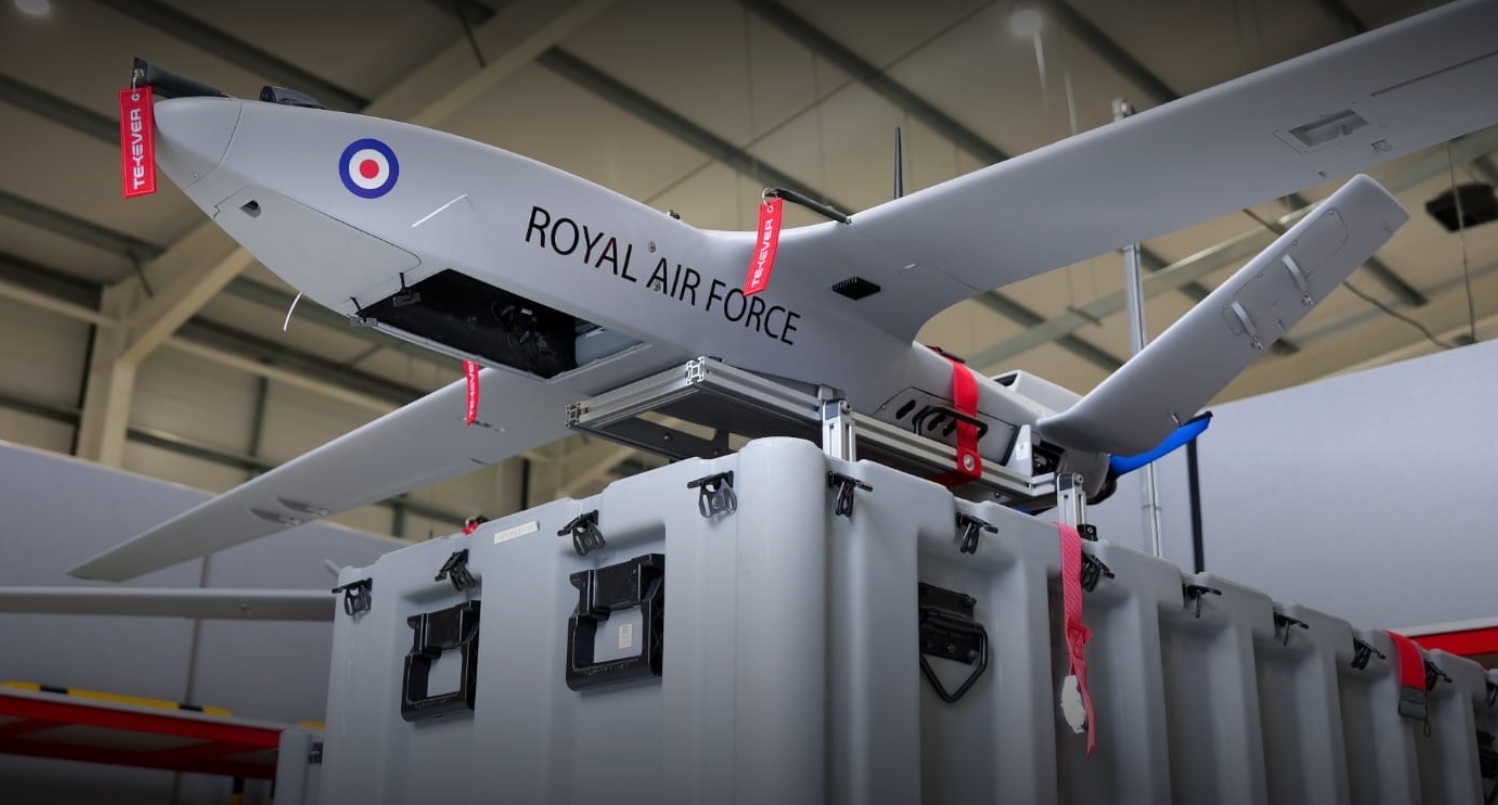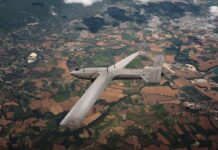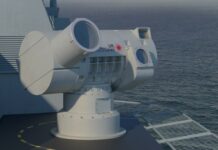RAF introduces StormShroud autonomous collaborative platform to protect manned strike assets
Peter Felstead
The UK Royal Air Force (RAF) introduced into service on 2 May 2025 a new unmanned aerial vehicle (UAV) platform known as StormShroud that is the first of a new family of autonomous collaborative platforms (ACPs) that will support RAF strike operations.
The StormShroud platform is based on the Tekever AR3 UAV and will support RAF F-35B Lightning and Eurofighter Typhoon operations by blinding enemy radars using Leonardo UK’s BriteStorm electronic warfare (EW) payload. BriteStorm features a radar jamming capability that disrupts enemy integrated air defence systems, improving the survival rate and operational effectiveness of the RAF’s crewed aircraft.
StormShroud has been developed in the UK by the RAF’s Rapid Capabilities Office, the catalyst team in the UK Ministry of Defence’s (MoD’s) Defence Equipment & Support (DE&S) organisation, the MoD’s Defence Science and Technology Laboratory (DSTL) and UK industry.
While Tekever is headquartered in Lisbon, Portugal, the StormShroud Tekever AR3 is manufactured in West Wales and Southampton, while Leonardo UK’s BriteStorm EWre payload is manufactured in Luton.
“The delivery of StormShroud marks a significant step for the RAF and Defence in the journey of integrated autonomous systems into frontline operations,” the RAF stated in a 2 May press release. “StormShroud is one of the first RAF high-risk capabilities, where cutting-edge technology is brought into service with a balanced and risk-aware approach to assurance, avoiding excessive time and cost penalties. Lessons learned from the war in Ukraine have boosted StormShroud’s production and it’s taken just a year from the Urgent Capability Requirement (UCR) being endorsed to delivering the new capability, significantly reducing programme time and costs. This will allow the RAF to defend against adversaries with greater numbers whilst updating our capabilities much faster than traditional approaches would allow.”
StormShroud will be operated by the RAF’s 216 Squadron, based at RAF Waddington in Lincolnshire, which was reformed on 1 April 2020 and tasked with testing future UAV technology. The squadron will be supported by the RAF Regiment and made up of regular RAF, Royal Auxiliary Air Force (RAuxAF) and other UK defence personnel. Squadron personnel will be trained to operate in small teams and in high threat environments. RAuxAF personnel are an essential part of 216 Squadron, supporting activities such as launch and recovery of StormShroud as well as the critical liaison and integration with RAF F-35B and Typhoon squadrons.
“The RAF’s exploration of ACPs is part of its broader strategy to embrace technological advancements and maintain its position as a world-leading air force,” the service stated. “The ACP Strategy is clear that the best way to optimise our strength against increasingly sophisticated adversaries is through a blend of crewed and uncrewed autonomous platforms operating together. It’s a more agile, adaptable and cost-effective model that significantly reduces the risks faced by pilots in conventional aircraft when flying and fighting in hostile environments. [UAVs] have revolutionised modern warfighting, both offensively and defensively, as recent conflicts ranging from Ukraine to the Middle East have shown. In a world of increasing threat to the UK and our NATO allies, StormShroud will serve as a powerful deterrent to potential aggressors.”
Air Chief Marshal Sir Rich Knighton, the UK Chief of the Air Staff, stated, “This is a seminal moment for the RAF to maintain our advantage in Air Combat and national security. The RAF is committed to exploring cutting-edge technologies that can enhance its lethality and survivability in a more contested and dangerous world. Autonomous collaborative platforms will revolutionise how we conduct a range of missions, from intelligence gathering to strike and logistical support. We are excited to be at the forefront of this innovation and are working closely with industry partners to explore the possibilities.”
Leonardo UK explained that BriteStorm “is a ‘stand-in jammer’: a sophisticated electronic warfare device designed to be deployed ahead of high-value crewed combat aircraft, flying on board small uncrewed aircraft or missiles. It suppresses and deceives an enemy’s integrated air defence system (IADS), degrading its ability to find and track allied aircraft. To deliver this effect BriteStorm employs high-powered digital jamming and deception techniques developed by Leonardo’s electronic warfare experts to be effective against a wide spectrum of threats. By generating confusion for the enemy, BriteStorm maximises operational freedom for friendly forces.”
The BriteStorm payload comprises a miniature techniques generator (MTG) along with a series of transmit receive modules (TRMs) tailored to the operator’s platform of choice. The payload is small, lightweight and has a low power requirement, allowing it to be integrated into a wide range of UAVs.
To future-proof the system against rapidly evolving enemy equipment and techniques, BriteStorm takes an open approach to software. Operators can configure the payload to defeat a wide range of threats and can exploit intelligence and mission data captured during sorties to update the payload to handle new threats as they emerge during operations.
Learning from recent operational lessons, BriteStorm has been designed to be attritable. On its return, BriteStorm is rapidly reprogrammable for subsequent missions, but if destroyed in the defence of higher-value or crewed platforms, its loss would be tolerable.
Research and development of BriteStorm began at Leonardo’s Luton site in 2017.
The Tekever AR3 has a wingspan of 3.5 m and a payload capacity of 4 kg. Although there is a vertical take-off and landing (VTOL) variant, the standard fixed-wing AR3, which is catapult launched, has a flight endurance of 16 hours, a cruise speed of up to 90 km/h and a service ceiling of 3,600 m.
The RAF is reportedly expected to procure around two dozen StormShroud UAV platforms at an initial cost of GBP 19 million (EUR 22.3 million).
















